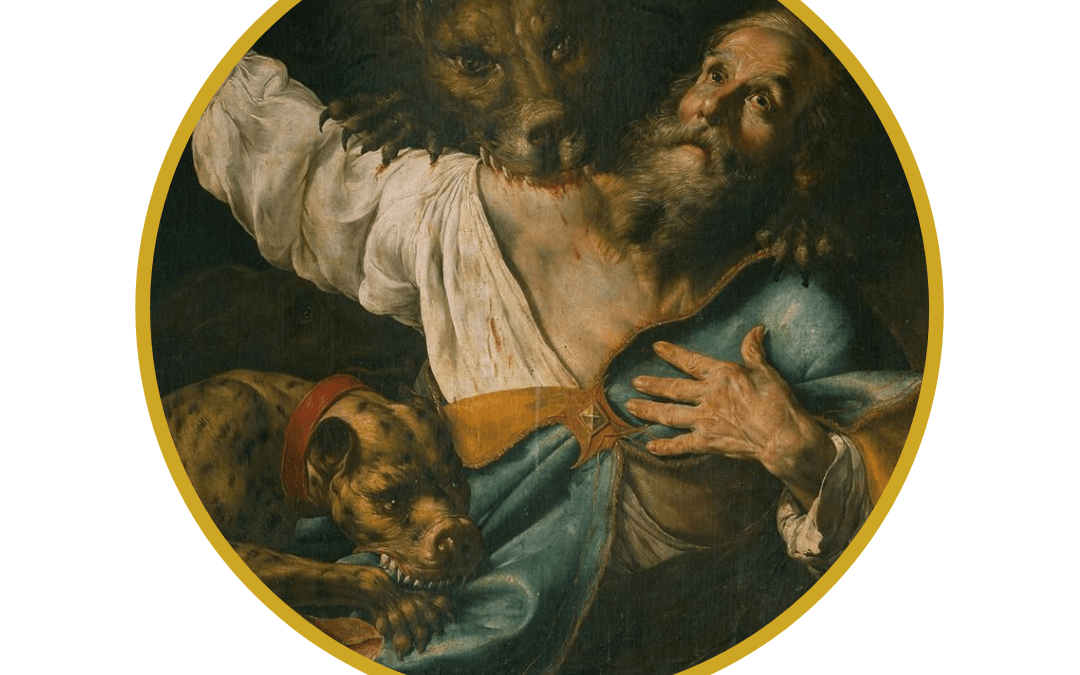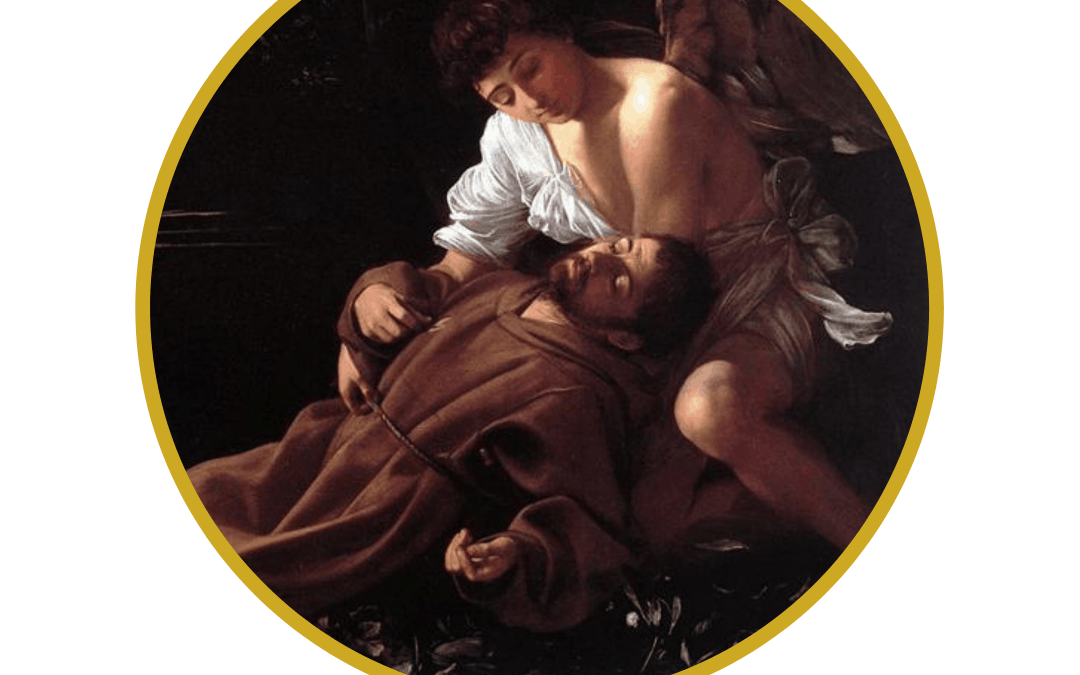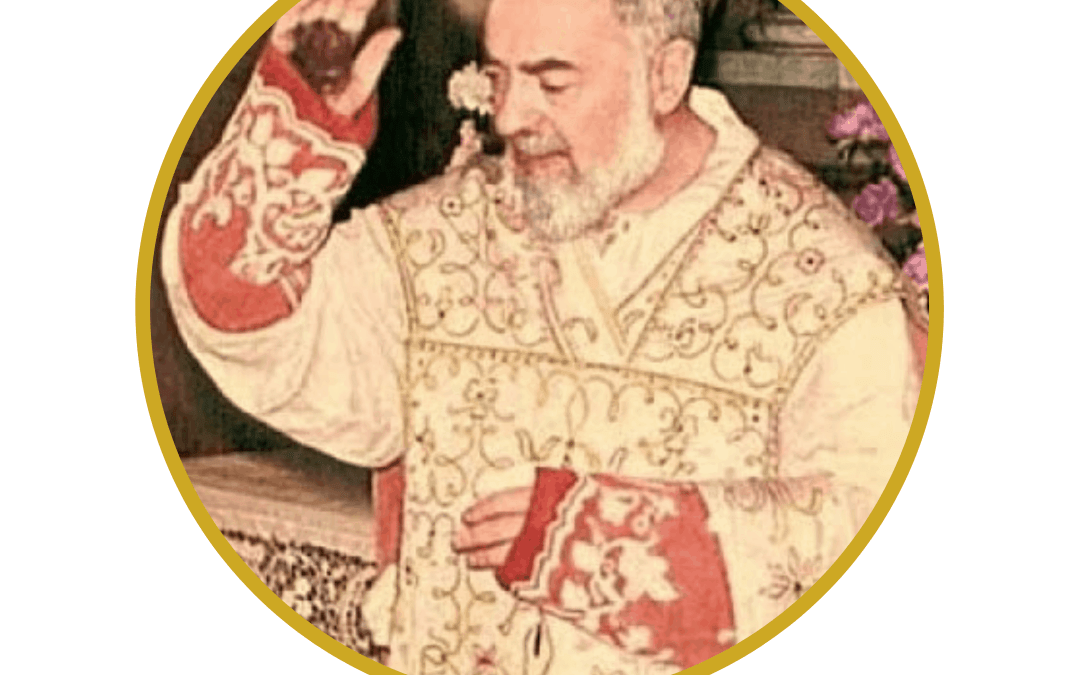
by popadmin | Oct 5, 2020 | CIC Saint Writeups
Saint Ignatius is an apostolic father and one of the great bishops of the early Church. He was born in Syria, converted to Christianity, and became a successor of St. Peter as Bishop of Antioch. He is said to have been personally instructed by the Apostle John. During the persecution of the Emperor Trajan, Ignatius would not deny Christ. He was condemned to death by wild beasts and sent in chains to Rome. During his final journey from Antioch to Rome, St. Ignatius wrote seven epistles (letters) which we still have today. Ignatius wrote to the Christian communities of Ephesus, Magnesia, Tralles, Rome, Philadelphia, and Smyrna; along with a farewell letter to Bishop Polycarp (also a martyr). The Letters of Ignatius are greatly honored by the Church; they stress the importance of Church unity, dangers of heresy, and the importance of the Eucharist as the “medicine of immortality.” His writings contain the first surviving written description of the Church as “Catholic” (indicating the universality of the Church). St. Ignatius also wrote of his burning desire for martyrdom. Pope Benedict XVI said that “no Church Father has expressed the longing for union with Christ and for life in him with the intensity of Ignatius.” Ignatius’ last words before the lions tore him to pieces: “Allow me to become food for the wild beasts, through whose means it will be granted me to reach God. I am the wheat of God, let me be ground by the teeth of the wild beasts, that I may be found the pure bread of Christ.”
Ideas for celebrating this feast day at home:
- Use lions as a theme for food/snacks today. Here is a neat idea for a lion vegetable tray. Or, bake a lion cake – the internet has lots of ideas for this!
- Do an autumn leaf lion craft with children.
- Make homemade wheat bread, remembering the last words of St. Ignatius.
- Find the epistles of St. Ignatius of Antioch here. Read and meditate upon his words.
- St. Ignatius had a gift for written letters/epistles: in his honor, write a letter to someone who is sick, lonely, or in need of a handwritten note to brighten their day.

by popadmin | Oct 4, 2020 | CIC Saint Writeups, Uncategorized
Francis was born in 1182 into a wealthy Catholic family of seven children in Assisi, Italy. He was named John by his mother at birth, after St. John the Baptist. His father renamed him Francis because he made his livelihood in France. Francis lived a life of comfort, leisure, and partying until he left to fight as a solider in two wars. He was taken prisoner for a year. Afterwards, he felt called to spend more time in prayer and service to the poor. While praying, Francis heard God tell him to “repair my house, which is falling into ruins.” Francis went to work repairing ruined churches. His father was angry with him for spending family money. Francis then left home, renounced his wealth, and took a vow of poverty. Francis never become a priest but his love of poverty and his joyful preaching converted people everywhere he went. He had a group of followers; their one basic rule was “To follow the teachings of our Lord Jesus Christ and to walk in his footsteps.” They traveled to Rome to get papal approval for their religious order. At first reluctant about this group of poor men, Pope Innocent III experienced a supernatural dream and then approved the founding of the Franciscan order. The Order grew quickly. A woman named Clare of Assisi wanted to take similar vows, so Francis helped her start the Order of the Poor Ladies (Order of Saint Clare). He also started another order (later called the Third Order of Saint Francis) for lay men and women. St. Francis received the stigmata during a 40-day fast preceding Michaelmas. Francis was also known for his love of nature and animals. There are many stories about Saint Francis preaching to animals and taming wild ones. One story tells of a vicious wolf in the town of Gubbio that was killing people and sheep. Francis confronted the wolf, made the sign of the cross and commanded the wolf not to hurt anyone else. The wolf became tame and the town was saved. In 1220, he set up the first known Nativity scene to celebrate Christmas. Francis became ill and spent the last few years of his life mostly blind. He died in 1226 while singing Psalm 141. He was declared a saint only two years after his death.
Ideas for celebrating this feast day at home:
- Bring your animals to church on Sunday, 4 October at 2pm for the Blessing of the Animals! Fr. Tomlinson will bless all your creatures in the grassy area by the handicap parking.
- Click here for Franciscan prayers you can say with your family on this feast day.
- In honor of his love of poverty, make it a task this week to declutter closets and donate extra items to the poor! Include your children in this endeavor to give out of your excess to those in need. Or, send the St. Vincent de Paul Society a donation.
- Francis fasted most of his religious life, so it’s not completely natural to prepare a great feast in his honor. However, on his deathbed, he asked for a sweet treat concocted of almonds and sugar. Here is a recipe that might be similar to what he requested. Because he was from Assisi, an Italian-themed dinner would also be fitting.
- Get out into nature today and enjoy an animal-themed snack (animal crackers, ants on a log).
- This website has other meal ideas in honor of St. Francis.

by popadmin | Sep 23, 2020 | CIC Saint Writeups
This feast, also known as “Michaelmas,” was a Holy Day of Obligation until the 18th century. The Catechism of the Catholic Church teaches that “The existence of the spiritual, non-corporeal beings that Sacred Scripture usually calls “angels” is a truth of faith. The witness of Scripture is as clear as the unanimity of Tradition.” Archangels are one of the nine choirs of angels listed in the Bible. (In ascending order, the choirs or classes are: Angels, Archangels, Principalities, Powers, Virtues, Dominations, Thrones, Cherubim, and Seraphim.) St. Michael’s name means “Who is like unto God?” and he is known as “the prince of the heavenly host.” St. Michael’s task is doing battle against Satan and all his evil followers. His name appears in Scripture four times. He is usually depicted as a mighty warrior and is known as a champion of justice; the guardian of the Church; the protector and defender of all the friends of God. We invoke St. Michael for help in the fight against evil and to rescue souls from Satan, especially at the hour of death. St. Gabriel’s name means “God is my strength” and appears as a messenger in the Bible three times (to the prophet Daniel; to Zachariah to announce the birth of John the Baptist; and to Mary at the Annunciation). St. Gabriel’s famous greeting to Our Lady at the Annunciation was: Hail Mary, full of grace. St. Raphael’s name means “God has healed.” Knowledge of St. Raphael comes from the book of Tobit. His mission as healer and fellow traveler with Tobias has caused him to be invoked for journeys and at critical moments in life. Tradition also holds that Raphael is the angel that stirred the waters at the healing pool in Bethesda.
Another angelic feast is celebrated this week on 2 October: Feast of the Guardian Angels. “From infancy to death human life is surrounded by their watchful care and protection. Beside each believer stands an angel as protector and shepherd leading him to life.” (Catechism of the Catholic Church, 336) St. Bernard wrote “…the angels are here; they are at your side, they are with you, present on your behalf. They are here to protect you and to serve you.” God has given each of us the incredible gift of a guardian angel – they will protect and help us attain eternal salvation. Deo Gratias!
“For he will give his angels charge of you to guard you in all your ways.” (Psalm 91:11)
Ideas for celebrating this feast day at home:
· Memorize the Prayer to St. Michael the Archangel. Pray it daily for protection from evil!
· In honor of St. Gabriel, Learn the Angelus. Traditionally, it is prayed at 6 and 12 o’clock
· Make recipes related to Michaelmas. St. Michael Bannock bread is traditionally served with roasted goose and carrots. Roasted chicken or Cornish hens work, too! An easy option is picking up a hot rotisserie chicken from the store. Other food ideas: make an angel food cake, devil’s food cake, angel hair pasta, or deviled eggs. For extra fun, poke cocktail swords (or little toy swords from play action figures) into your food! Decorate with white as symbolic of the angels.
· Do you have any angel-shaped Christmas cookie cutters? Use them to trace and color angels to decorate the house! OR, bake up some sugar cookies in angelic shapes this week.
· Folklore says that Michaelmas day is the last day that blackberries can be picked and eaten because when St. Michael expelled the devil from heaven, he fell from the skies and landed in a prickly blackberry bush. Satan cursed the fruit, stamped and spat on it, making them unfit for eating. So, on this feast day: enjoy blackberry wine or buy fresh blackberries to put on oatmeal, bake into a pie or cobbler, or top an angel food cake with them.
· Saint Michael is the patron saint of police officers. This is the perfect day to stop by your local police station with thanks and treats. Tell them that it’s their feast day so you brought some food for feasting and you are praying for them in a special way on Michaelmas.
· Don’t forget to memorize the Prayer to your Guardian Angel on October 2!

by popadmin | Sep 20, 2020 | CIC Saint Writeups
23 September: Feast of Saint Padre Pio. This feast is in honor of Italian Franciscan priest St. Pio of Petrelcina, better known as “Padre Pio” and renowned for his suffering, humility and miracles. Padre Pio was born Francesco Forgione in 1887 as one of seven children. His growing up years were marked by daily Mass, family rosary, and acts of penance. He decided at a young age to dedicate his life to God. In 1903, he put on the Franciscan habit as a Capuchin Friar. Capuchin priests seek extreme poverty, strictness, and simplicity. He took the name Pio, a modern Italian form of “Pius,” in honor of Pope St. Pius V. He was ordained a priest in 1910. Padre Pio suffered through health problems and serious illness. He experienced religious ecstasy and attacks from the devil (friars would report strange noises from his cell). In 1918, Padre Pio first received the painful Stigmata – the five wounds of Christ’s passion. This made him the first stigmatized priest in Church history. During World War I, Padre Pio served in the military and offered his own personal suffering for an end to war. Once again, he received the Stigmata wounds. They would remain with him for 50 years. Countless doctors looked at his wounds with no explanation. His wounds bled painfully every day with no drop in blood pressure. Against his wishes, Padre Pio’s reputation for holiness and miracles began to attract crowds. Countless people flocked to his confessional and many more received his saintly counsel and spiritual guidance through correspondence. His life was marked by long hours of fervent prayer and patient suffering. Padre Pio died in 1968, and was declared a saint in 2002.
Ideas for celebrating this feast day at home:
- Watch this reflection with Deacon Gus
- Today’s menu should include Italian foods in honor of this Italian born saint (cappuccino, pasta, risotto, pizza, etc). For today’s feast day treat, make easy “Stigmata rice krispy treats”: use a hand shaped cookie cutter (or your own hand as a guide!) to cut out rice krispy treats. Use a dab of red icing in the center of the hand treats to look like a Stigmata.
- St. Padre Pio loved to hear confessions: his feast day is a great reminder for us! Put it on your calendar and make a commitment to go to confession soon.
- Watch a free video on FORMED about Padre Pio
- Family prayer time: St. Padre Pio said that “Prayer is the oxygen of the soul.” Before bedtime, kneel together as a family and take turns praying. Try to make this a part of your daily routine. Padre Pio’s own family was known for praying a family rosary – try to add this to your family life, too! Pray virtual rosaries with your parish family (click here for the link to pray at 7pm on Su, Mo, Tu, Thu, Fr). This is a beautiful way for your children to see prayer modeled by their parents and fellow parishioners.
![14 September 2020: Feast of the Exaltation of the Holy Cross]()
by popadmin | Sep 13, 2020 | CIC Saint Writeups

This feast day focus is on the cross itself and commemorates three historical events: the finding of the True Cross by Saint Helena; the dedication of the churches built by Constantine on the site of the Holy Sepulchre and Mount Calvary; and the restoration of the True Cross to Jerusalem by the emperor Heraclius II. After the resurrection of Christ, Jewish and Roman authorities tried to hide the Holy Sepulchre, Christ’s tomb. Earth was mounded up and pagan temples were built on top. Tradition said the Cross on which Christ had died had been hidden somewhere in the vicinity. Saint Helena (mother of the emperor Constantine) was divinely inspired to travel to Jerusalem in 326 to find the True Cross. Three crosses were found. Saint Helena and Saint Macarius, the bishop of Jerusalem, devised an experiment to determine which was the True Cross. The crosses were taken to a woman who was near death; when she touched the True Cross, she was healed. Another tradition says the body of a dead man was brought and laid upon each cross. The True Cross restored the dead man to life. Constantine constructed churches at the site of the Holy Sepulchre and Mount Calvary. Those churches were dedicated and the Feast of the Exaltation of the Holy Cross was celebrated. The feast slowly spread from Jerusalem to other churches, until, by the year 720, the celebration was universal. In the early seventh century, the Persians conquered Jerusalem and captured the True Cross. Heraclius II defeated them and restored the True Cross to Jerusalem. Tradition says that he carried the Cross on his own back, but when he attempted to enter the church on Mount Calvary, a strange force stopped him. Patriarch Zacharias of Jerusalem, seeing the emperor struggling, advised him to take off his royal robes and crown and to dress in a penitential robe instead. As soon as Heraclius did so, he was able to carry the True Cross into the church. This feast day, more than anything else, is a celebration of God’s greatest work: His death and resurrection which defeated death and opened Heaven. Christ transformed an instrument of torture and humiliation into a symbol of salvation. The entrance antiphon for this Feast: “We should glory in the cross of our Lord Jesus Christ, for he is our salvation, our life and our resurrection: through him we are saved and made free.”
Ideas for celebrating this feast day at home:
- Watch this reflection from Deacon Gus Suarez (here)
- Craft project: make and decorate a cross. Build a “yard cross” out of big pieces of lumber or tree limbs. Make sure that blessed crucifixes are displayed prominently throughout your home.
- Eat foods like red tomatoes, and drink beverages such as fruit punch or red wine, reminding us of the blood Jesus shed. Mozzarella cheese is white and reminds us of our baptismal garments (when we were signed with the cross). Cook with sweet basil, which tradition says grew over the place where the True Cross had been buried. Use wooden skewers and make an appetizer of tomatoes, basil, and fresh mozzarella cheese. The wood of the skewers reminds us of the wood of the cross. Idea Or, just enjoy pasta night with the above ingredients!
- Make a dessert in the form of a cross, or decorated with a cross. Although usually made on Good Friday, hot cross buns would also be perfect for today. Recipe
- Pray the Stations of the Cross. The prayer repeated at each station: We adore You, O Christ, and praise You, Because by Your Holy Cross You have redeemed the world.
- Available on FORMED is a story about St. Helena and the True Cross: watch





Recent Comments